Using Trees as Antenna Supports
last updated 8 February 2022
Trees are my favorite portable antenna support. A large part of that, of course, is that I tend to operate in areas that have lots of trees, sometimes over 40m (130 ft) tall.
Like many other hams, I started my portable operation trying to throw an end-fed wire over a tree branch. This has several problems:
- it requires a branch at just the right height
- wire isn’t as easy to throw as rope
- it was often difficult to pull the wire back down from the tree with the weight on the end
As a result, I switched to throwing a rope over the tree and using it to pull up the wire, which is easier to do, accommodates a wide range of trees, and makes it easier to pull everything down from the tree afterwards.
How high I put an antenna in a tree depends on the application (as well as the available trees, of course). For backpacking, when I only carry 8m (25 ft) of coax, typical heights are 4 – 6 m (12 – 20 ft). For casual portable operation, as well as emergency response, 6-10m (20 – 30 ft) is more common. For Field Day, or when I am otherwise focused on longer distance communications, I may push for 15 – 20 m (40 – 65 ft), or higher when possible.
Simply having trees around you, however, doesn’t mean that it is always easy to get an antenna up into them. Sometimes they are too dense, and other times there might be very few branches less than 20m off the ground that I can throw a rope over.
So let’s consider some of the different issues about using trees as antenna supports, including:
Shapes of Trees
One of the reasons why people have different experiences of using trees to support antennas is because trees, and forests, vary widely in many ways. Consider the following examples:
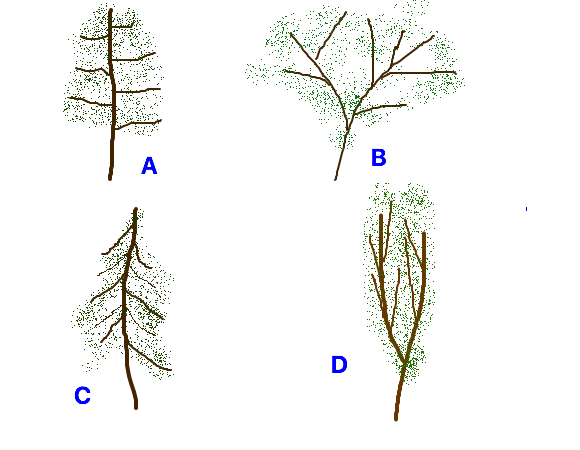
The shape shown in A is typical of many large conifers, such as Douglas Fir, Ponderosa Pine, or Sitka Spruce, as well as some broadleaf trees with a single trunk. It has relatively large horizontal branches, often with gaps between them such that a weight thrown over a branch may pass through and back down to the ground with relatively little other contact with the tree. The trees tend to be much taller than they are wide. Such trees are some of the easiest to use for antennas.
The shape at B is typical of many large broadleaf trees. The canopy may be wider than the tree is tall. Sometimes it is possible to select a particular limb near the outside of the tree, and other times the best approach may be to throw the rope over the entire tree (if it isn’t too tall), or just throw it into the middle of the tree and hope for the best. Often there are so many small branches that it is difficult to get a rope over a stronger branch.
Shape C is typical of some conifers and other trees with branches that angle downwards, such as some larches and cedars. This can be a problem because the branches bend downwards under pressure, and the rope can slip off the ends when trying to support a vertical load. For a horizontal load like end of a dipole, this may require that the rope be angled sideways around the back of the tree to keep it from slipping off.
There are several types of trees with shape D, often tall, skinny types. A problem with this is that, when the rope is thrown over center of the tree, it may slip down a long distance before finally catching in a crotch. Similarly, it is more difficult to pull a weight back through such a tree if it gets tangled, as the crotches are quite narrow.
There are other types of trees that can be problematic. Many palm trees, for example, have leaves with edges that the rope can catch on, and some thorny types can grab the rope. Ones with rough bark or lots of smaller branches may have higher friction on the rope: they may require a heavier weight to get the end down to the ground.
So pay attention to the trees where you will be operating and adjust your methods as needed.
One other problem I have found is in old stands of tall trees: in the center, where it is heavily shaded, it may be quite open between the tree trunks for hanging antennas, but there may not be a lot of branches below 20 m (65 ft) or so to hang antennas from. When the forest is thick, it may be necessary to string the antenna along a trail or road, making use of trees beside it: watch out for power lines, however.
Rope Throwing Methods
There are several common methods for getting a rope over a tree branch, including:
- throwing
- hitting (with a tennis racquet, golf club, cricket bat, etc.)
- slingshot / catapult
- bow and arrow
- fishing rod
- compressed air cannon (“spud gun”)
- drones, kites, balloons, etc.
- a long pole
Throwing
Throwing a rope is probably the simplest method in terms of required equipment, but is not as easy as it might appear. It is much more difficult for the human arm and shoulder to throw a ball upwards at a high angle than to throw horizontally. After many tries, with limited success, I discovered I actually did better throwing underarm, which naturally goes more upward, although my height was still limited. When I held onto the rope instead of the weight, and let the weight swing to develop more momentum, I could get higher in the air, which led to my standard throwing bucket. With it, heights of 12m (40 ft) are no problem, and my maximum height is around 20 m (65 ft) or so, depending on the choice of weight and rope. The bucket is to contain the rope so it doesn’t tangle on grass and sticks: I started out just laying down a tarp or blanket and laying out the rope back and forth on that: it works, but the “bucket” is faster and more compact, and can be carried easily from one antenna to the next.
One of the most common problems with trying to throw a rope over a tree is using a weight that is too light. It often is easier to get the weight over the target branch than to get it back down to the ground on the other side. The primary variables are the friction of the rope running over the bark on the tree branch, the weight of the ball, and the momentum the ball has when it clears the branch. The friction can be reduced by using a smooth, tightly braided, flexible rope, or fishing line, rather than softer twisted ropes. When I find a good rope, it gets dedicated for throwing: I use it to pull up a different rope to support the antenna, then put the throwing rope back in the bucket.
One variation on throwing is the use of a Chuckit® or similar, a plastic throwing handle to throw balls for dogs to chase. I haven’t done as well with it, but some others have.
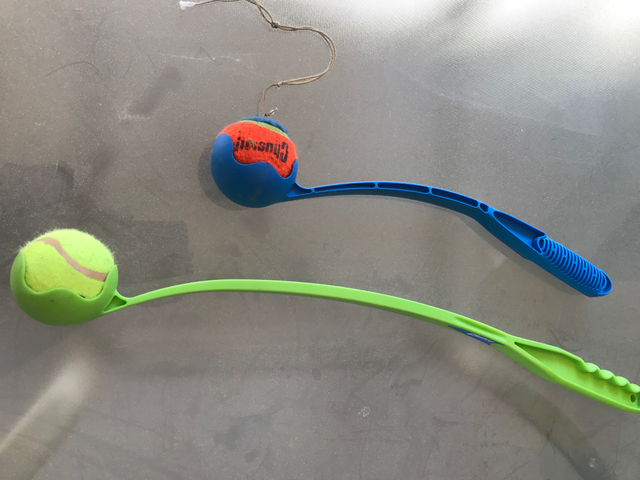
Hitting
There are many sports (such as tennis, golf, cricket, baseball, or hurling) where a ball is hit with some sort of club-like device. If you have the necessary equipment and skill, then attaching a rope to the ball and hitting it over, or into, the tree may worth trying. Personally, I have neither the equipment or the skill, so I can’t give you any particular advice, except to experiment and see what works. You can use a throwing bucket to hold the rope.
Slingshot / Catapult
The most common types use rubber tubing for power. Unfortunately, they often aren’t designed to shoot enough weight to lift the line over a branch with a heavy enough weight to get it back down. Doubling the rubber tubing to give more force for the same draw distance may help.
I prefer the type that brace against the wrist. The photo below shows a standard type with a fishing reel attached to the wrist brace with a hose clamp. This takes a bit of work to keep the line from tangling, but with the right weight (often a fishing sinker or large metal nut), and some practice, it can be a useful combination.
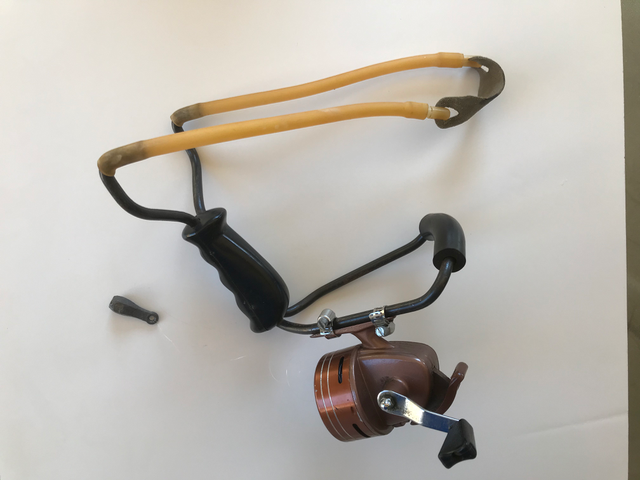
I have a larger one designed for launching tennis balls for dogs to chase. While it does this well, it has fairly limited range with my weighted balls. With a 45 g (1.6 oz) weight and my lightest throwing line, I can get about the same height as I can with my throwing bucket, but with somewhat better accuracy, as long as it does not have to pass through a lot of leaves.
I have seen commercial versions designed for professional arborists who work in trees, that shoot a small bag of sand. These have a long handle that is designed to rest on the ground. I wasn’t too impressed when I tried one – it didn’t seem to do any better than my throwing bucket, and was a lot more expensive. It may be capable of greater height with one person holding it and another firing it.
One issue with using slingshots / catapults is that they may be considered weapons, and are not permitted in many parks. Even if they are permitted, when you are sharing the park with others, throwing tennis balls appears a lot safer to others around you than firing a weapon into the air.
Bow and Arrow
This is one of the more effective methods I have used, both for range and accuracy, when I had a bow available. I made two modifications to the arrows: first I drilled a small hole through the (wood) arrow shaft just above the nock that allowed me to pass a loop of fishing line through the hole and around the back of the arrow. That made it easy to unhook the arrow from the fishing line. The arrow also needs more weight to pull the fishing line over the tree and back down to the ground. My simple solution was to tape several nails to the head of the arrow. While this worked, it still permitted the point of the arrow to stick in the tree. A better solution would be to use the brass bullet shell from a 7.62 mm (0.30 caliber) or similar size rifle filled with sand in place of the point on the arrow.
Special fishing line reels are sold for bow fishing, but standard types can be attached to a stake in the ground, or, with some creativity, mounted to the front of the bow.
The use of a bow and arrow in a park with other people around raises serious safety concerns. Don’t rely on the rope to stop the arrow: it is not uncommon for it to break.
Fishing Rod
Fishing regulations and equipment vary widely around the world. At least in the US, “spinning reels” are designed to cast (throw) a light line far out into a lake or river. The same rod and reel can be used to cast a weight over a tree if aimed more upwards. Just remember not to leave any hooks on the line, or it may be rather difficult to get it down out of the tree.
Compressed Air Cannon (“Spud gun”)
These are typically made of plastic pipe, pressurized with an air pump, and used to shoot a projectile (“spud” is slang for a potato) over a tree. Many of them can reach over 30m (100 ft) high. Some are designed to shoot tennis balls, but the required pipe size is not common, so often they are used with other objects.
Caution: In the US, the PVC pipe that is commonly used to build these is not rated for use with compressed air, even though it is rated for water under higher pressure. The difference is that water doesn’t compress, so a small leak quickly removes the pressure, while compressed air can blow the pipe apart with considerable force once it starts to crack. Be careful!
An internet search for “pneumatic antenna launcher” should provide more information. Again, safety of others needs to be a primary concern, along with local regulations about whether such a device is considered a weapon.
Drones, Kites, Balloons, etc.
Drones are a relatively new approach: ideally you would attached the weight on a rope to a drone, send it up and over a tree, then land it on the other side. One problem with this approach is that the rope can tangle in the propellers when the drone is descending.
Another approach is to fly over the tree and drop the weight down the other side. However, most simple drones don’t have a control for releasing the payload, so it needs to be secured in some way that it can be dislodged by tilting the drone in some direction, or possibly by pulling a a rope from the ground that has been walked around to the other side of the tree.
I have seen various methods using kites or balloons over the years, but none that look good enough to try. In most cases, they are more suitable for putting a rope over the whole tree rather than just over a branch, and for stand-alone trees rather than those in a forest.
A Long Pole
Actually, this is a quick and simple method that I use up to 5 m (16 feet) or so, such as for hanging a VHF J-pole antenna or an short 80m wire vertical for a transmitter hunt. I use a pole about 2m (6 ft) or longer, or a telescoping handle of some sort, with a hook on the end with the open side up. I make a larger hook with soft wire that will fit over a tree branch and tie that to the top of the antenna. Then I use the pole to lift the antenna hook up and over a convenient branch of the tree, as high as I can reach. The reason for using soft wire for the hook on the antenna is that, when I’m done, I pull on the coax, and the hook bends and comes down. You may need to experiment to find the right wire type and hook size that will hold up your antenna without requiring too much tension on it to pull it down.
Telescoping poles sold for stringing Christmas Lights work well for this.
Antenna Configurations
Once you have one (or more) ropes over branches, there are many different ways that antennas can be installed, depending on your antenna and the direction(s) of interest. Here are some examples, showing dipoles, loops, ground planes, single wires, quads, and yagis supported by one or two trees:
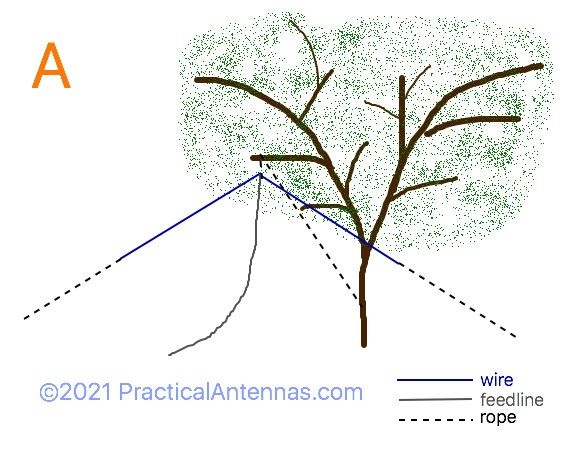
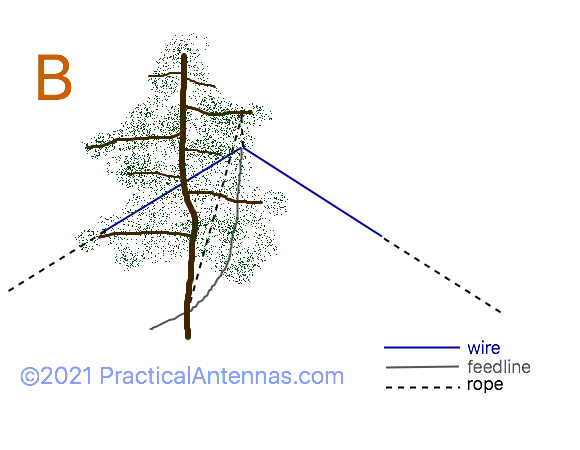
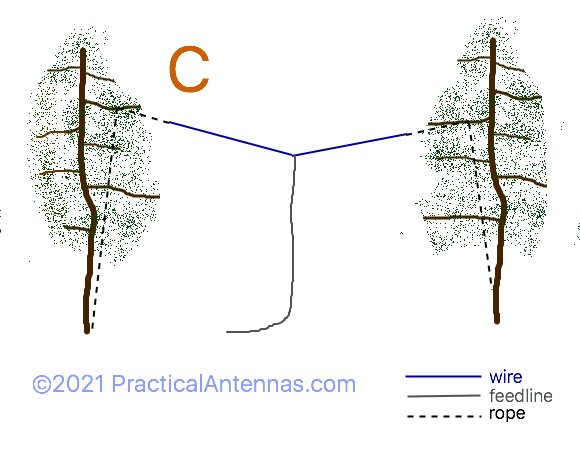
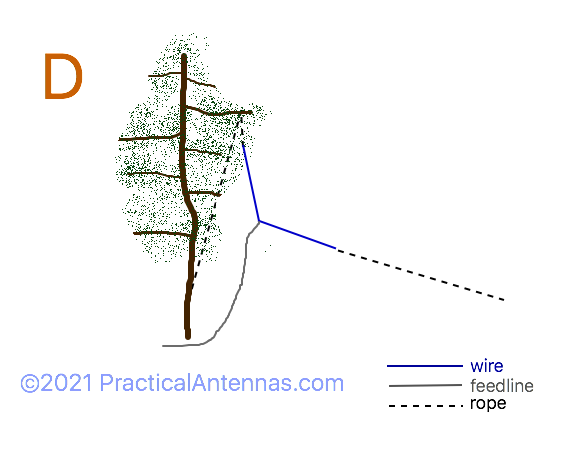
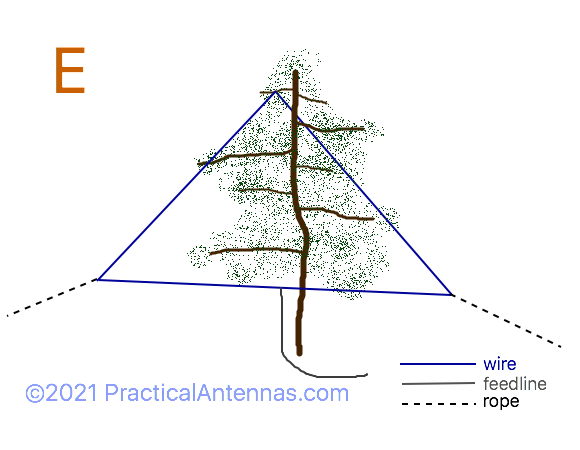
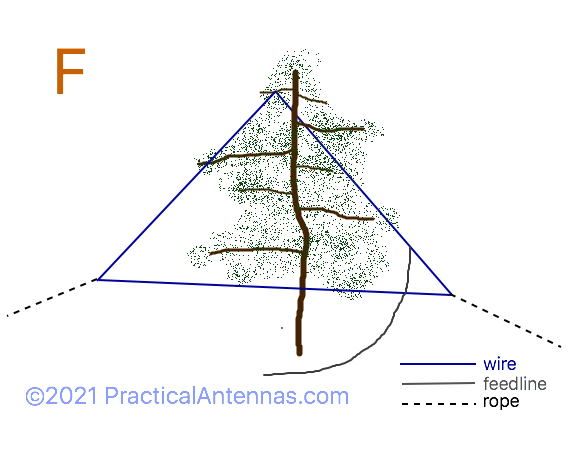
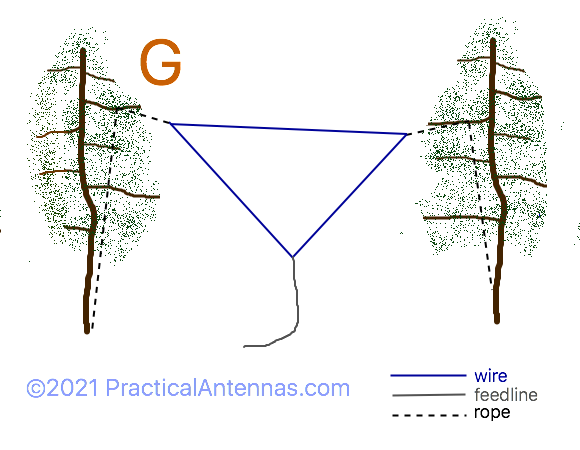
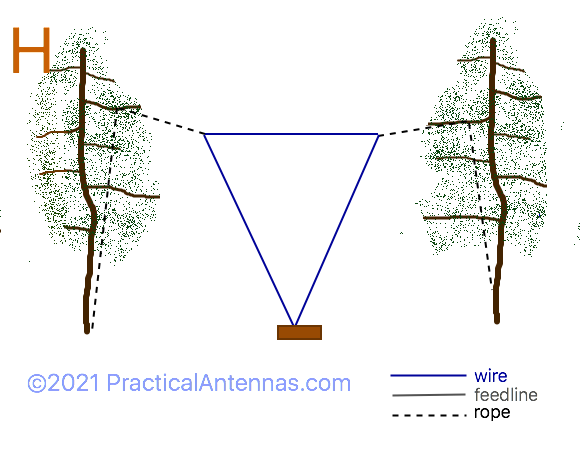
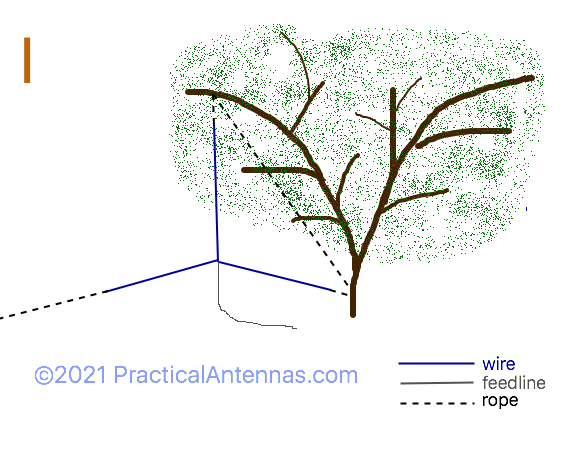
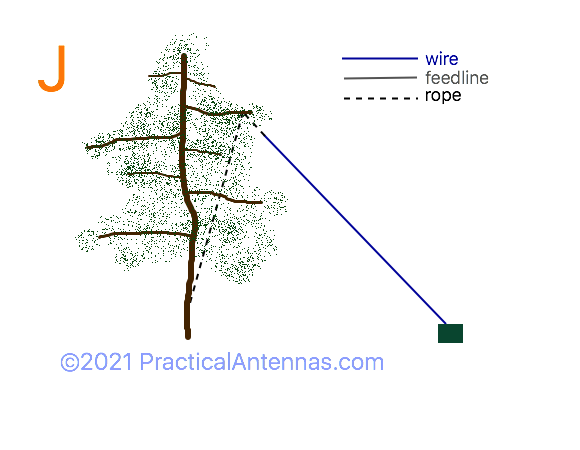
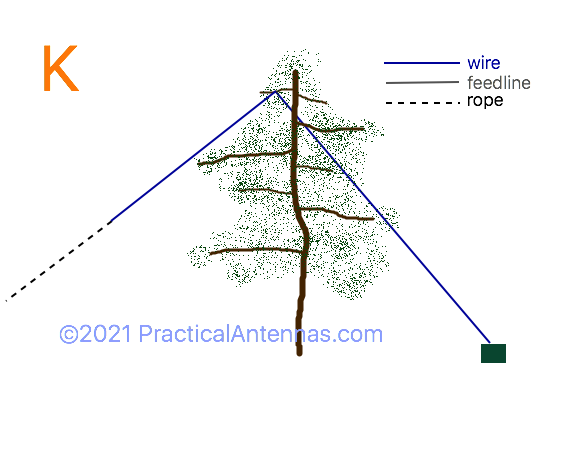
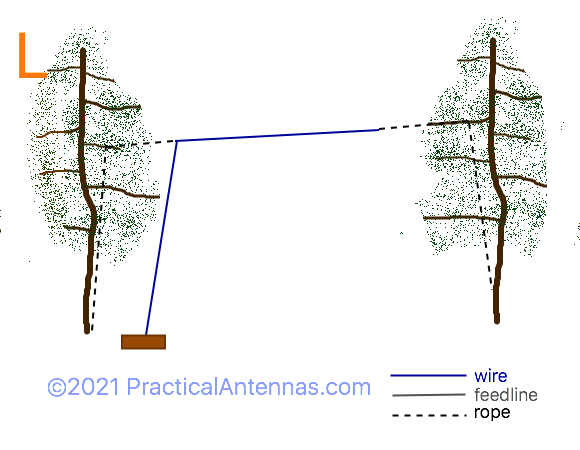
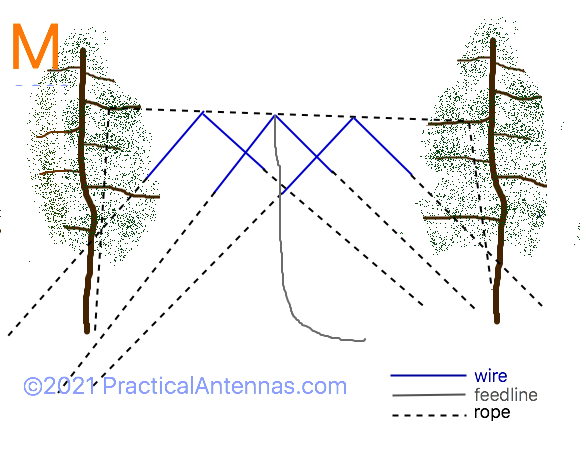
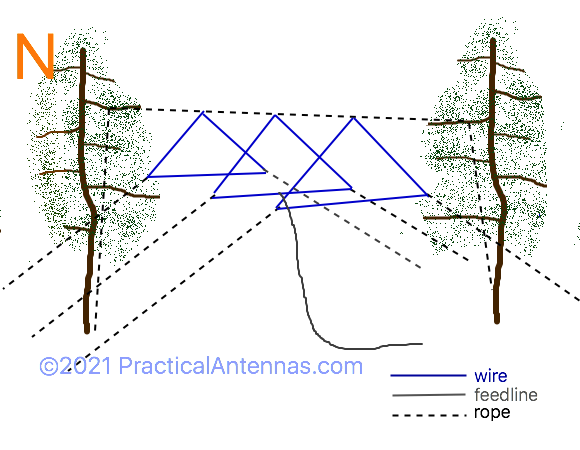
Example A shows my most common dipole / inverted Vee setup for casual operation: I don’t need the highest branch in the tree, just a convenient one at a reasonable height.
B shows the use of a higher branch: this may require pulling the wires and feedline to the side to clear the branch below it.
C shows another common installation – a dipole strung between two trees.
D is a sloper that I sometimes find convenient when the most convenient branch is too high for my feedline length.
E shows a delta loop hung over a branch for horizontal polarization. Note that, in this drawing, the wire is passed over a branch: this requires that one end of the loop be available to pull up the loop. If the loop is permanently connected so there is no free end, it can be raised with a rope. This arrangement puts the feedpoint at the bottom of the loop, so less feedline is required.
F shows the same loop fed for vertical polarization. The same wire loop can be used both ways by just rotating the wire, but the resonant frequency may shift in the process.
G shows a delta loop strung between two trees: the flat top and point at the bottom maximizes the effective height of the loop, giving similar performance as a dipole with a shorter feedline.
H shows how a 50 ohm delta loop can be suspended with the feedpoint right at the radio, so no feedline is needed.
I is a quarter wave wire ground plane with two elevated radials suspended from a branch.
J is a common method of hanging an end-fed wire.
K permits a longer end-fed wire by running it over a tree branch and down the other side.
L is another way to install an end-fed wire, as an inverted “L” using two trees.
M shows a 3-element wire yagi suspended from a rope boom between two trees.
N shows a similar approach for a 3-element delta loop beam.
Permanent Installations
Trees can also be used for more permanent installations, but because they are living, dynamic objects, they require some additional care and planning.
Perhaps the most important factor is that trees move in the wind, which can put immense strain on an antenna if it is secured to one. This is a common cause of antenna failure, especially when the antenna is pulled tight so it doesn’t sag. Reducing the tension on the antenna, or using a counterweight at one or both ends, will help to reduce the chance of breakage. For temporary use, tying the ropes off to the end of a branch may help, if the branch can bend when the tension increases.
Another important factor is the growth of the tree: a given branch stays at the same height as the tree grows, but a rope passing over a branch can not only damage the bark as it grows, but the tree can grow around it so it can no longer move. A screw eye into the tree, with room for the tree to grow before it closes the eye, is generally a better approach (although some locations have laws against putting screws or nails into trees). Some hams have covered their rope with a rubber hose where it passes over the tree branch: even if the hose gets stuck to the tree, the rope can still slide inside it.
If you need to use a counterweight, you might use one rope (that isn’t intended to move) to hold a pulley, and hang the counterweight at the end of a rope through the pulley. (Counterweight ropes that pass over a branch, rather than through an eye or pulley, often get hung up on the bark and don’t work as well.)
When you are planning to use a tree for a longer term, it may be worthwhile climbing it (or hiring a professional arborist to do so) and mounting a permanent pulley with a halyard at a convenient point.
If you attach a cleat to the tree to tie off your rope, you might want to put a block of wood between it and the tree to give the tree some room to grow. I recently helped a ham repair his antenna, and the tree bark had grown around the cleat he had mounted on the trunk of tree. It took him about 15 minutes with a hammer and chisel to clear the bark enough to untie the rope.
If you have a strong enough tree, I have seen hams trim back the top of the tree and attach a short mast to the top of the trunk for mounting antennas (including tri-band yagis). Getting the yagi up the tree and installed is not necessarily easy, and in some cases the surrounding trees may need to be trimmed back to permit the antenna to rotate. First, however, make sure that the tree is healthy (some can be rotted in the center). Plan on additional pruning every 1 to 3 years, depending on the rate of growth, as the top branches will tend to try to turn upwards. Also make sure you keep the tree healthy: it will last longer alive than dead.
Tree Health
Perhaps the most common mistake that damages a tree (as opposed to damaging an antenna) is putting too much pressure on a rope that passes around a tree limb, or having such a rope move back and forth. This damages the bark, and can “choke” the the limb as it grows, until the branch dies. A screw eye into the wood, or an eye bolt through a limb with a nut and washer on the back side, is actually much better for the tree than a rope or strap around a branch. This is because the living part is the area just under the bark, while the strength is mostly in the dead wood in the center. You want minimize the amount of bark that is disturbed. Also, there are different types of sealant that can be applied where the tree has been cut or otherwise damaged that aren’t covered by bark: these help to prevent the tree from getting infected.